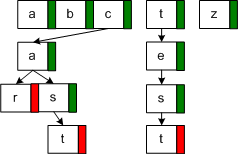Download Trie.zip Trie is a tree like data structure that can be used for fast text search. While there are a lot of examples on the internet, very few if any are written in C#. In this post, I would like to show a complete implementation in C#. In my implementation, the Trie nodes are represented by an array of pointers. While it is not the most efficient way to do, it nevertheless gets the point through. An alternative and more efficient way to do would utilize a linked list in place of the array of pointers. The following figure illustrates how I implement the Trie structure.
Here is the code for the TrieNode class.
class TrieNode {
public TrieNode[] nodes;
public bool isEnd = false;
public const int ASCIIA = 97;
public TrieNode() {
nodes = new TrieNode[26];
}
public bool Contains(char c) {
int n = Convert.ToByte(c) – ASCIIA;
if (n < 26)
return (nodes[n] != null);
else
return false;
}
public TrieNode GetChild(char c) {
int n = Convert.ToByte(c) – ASCIIA;
return nodes[n];
}
}
Whenever the TrieNode gets initialized, an array (representing 26 letters) of pointers is created. And Contains() method returns true if the corresponding node contains a reference (think of pointers) to a child. And finally, GetChild() function returns a child tree that is rooted at the character passed in. Note that the GetChild function only works level by level, e.g. for word “boot”, you will need to pass in the whole word and then scanning from left to right, and at each letter, you would call GetChild to get a tree that representing the current tree from that letter on. This makes intuitive sense, because if you do not call this function sequentially, how would you tell which “o” you are referring to? Take a look at the Tries class, and this concept should become clearer.
class Tries {
private TrieNode root = new TrieNode();
public TrieNode Insert(string s) {
char[] charArray = s.ToLower().ToCharArray();
TrieNode node = root;
foreach (char c in charArray) {
node = Insert(c, node);
}
node.isEnd = true;
return root;
}
private TrieNode Insert(char c, TrieNode node) {
if (node.Contains(c)) return node.GetChild(c);
else {
int n = Convert.ToByte(c) – TrieNode.ASCIIA;
TrieNode t = new TrieNode();
node.nodes[n] = t;
return t;
}
}
public bool Contains(string s) {
char[] charArray = s.ToLower().ToCharArray();
TrieNode node = root;
bool contains = true;
foreach (char c in charArray) {
node = Contains(c, node);
if (node == null) {
contains = false;
break;
}
}
if ((node == null) || (!node.isEnd))
contains = false;
return contains;
}
private TrieNode Contains(char c, TrieNode node) {
if (node.Contains(c)) {
return node.GetChild(c);
} else {
return null;
}
}
}
Now let’s see how we would use our Trie class to check whether a given string is present from an input string.
class Program {
static void
Tries tries = new Tries();
TrieNode n;
string s = @"
In computer science, a trie, or prefix tree,
is an ordered tree data structure that is used to
store an associative array where the keys are strings.
Unlike a binary search tree, no node in the tree
stores the key associated with that node;
instead, its position in the tree shows what key
it is associated with. All the descendants
of any one node have a common prefix of the string
associated with that node, and the root is associated
with the empty string. Values are normally not associated
with every node, only with leaves and some inner nodes
that happen to correspond to keys of interest.
";
s = s.Replace("\r\n", "");
string[] ay = s.Split(‘ ‘, ‘,’, ‘;’, ‘.’);
foreach (string str in ay) {
if (str != "")
n = tries.Insert(str);
}
Console.WriteLine(tries.Contains("prefix"));
Console.WriteLine(tries.Contains("come"));
Console.ReadKey();
}
}


